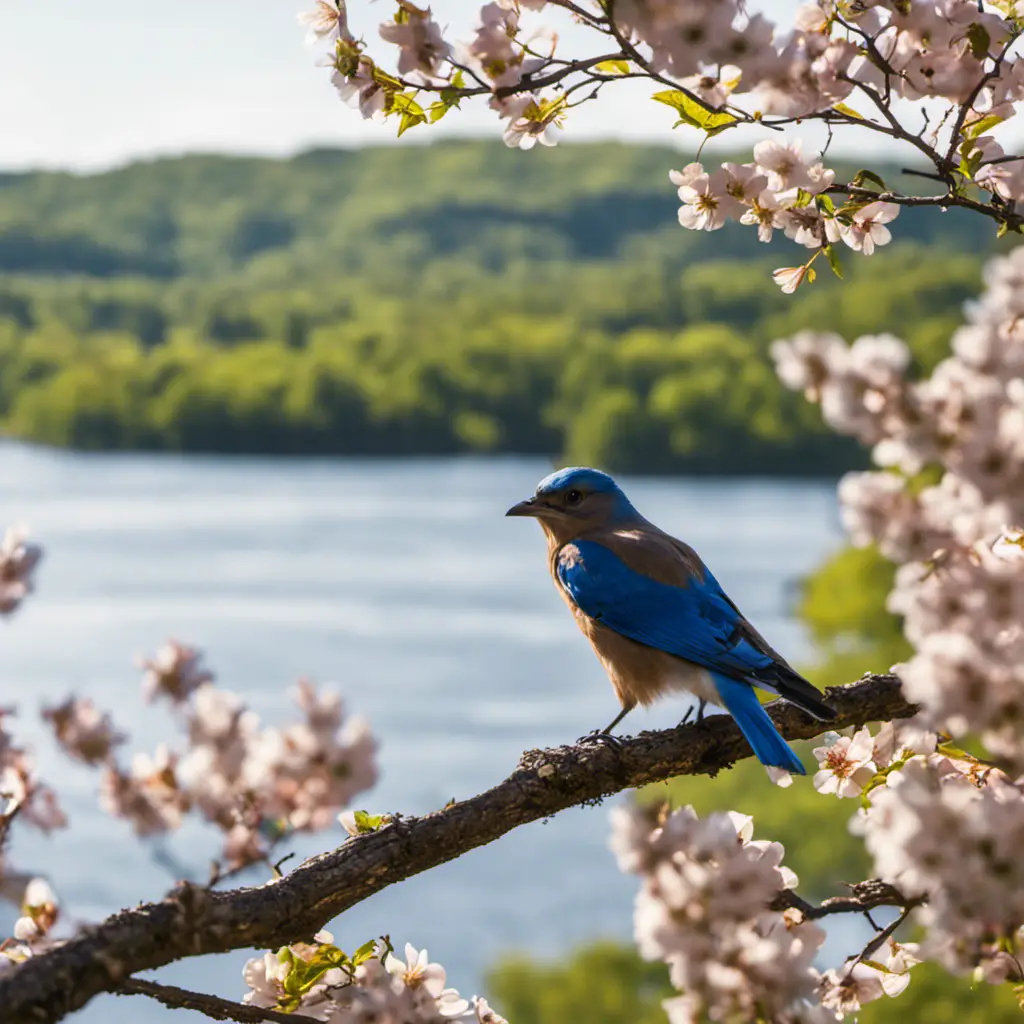Did you know that Arkansas is home to more than 350 different species of birds? From the American goldfinch to the bald eagle, there is something for everyone to see! In this blog post, we will take a look at some of the most common birds in Arkansas. Whether you are a beginner or an experienced bird watcher, we hope that you will find this information useful!
Common Backyard Birds in Arkansas:
American Goldfinch
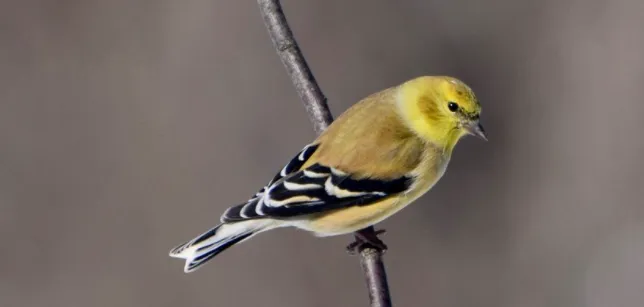
The American Goldfinch is a small, cheerful bird that is easily recognized by its bright yellow plumage. These birds are often seen flitting about in open fields and gardens, where they feed on seeds and insects. Goldfinches are relatively small birds, measuring only about four to five inches in length.
They have stout bodies with short necks and tails. Their wings are relatively short and rounded, and their legs are fairly short as well. Goldfinches typically have black wings with white wing bars, and their backs are often a muted brown or olive color.
The males of the species tend to be more brightly colored than the females, with brighter yellow plumage.
Goldfinches are social birds that often travel in small flocks. They are not particularly vocal, but they do make a soft twittering sound. These birds are also known for their distinctive call, which has been described as sounding like “potato chip.”
Goldfinches are found throughout North America, and they typically breed in open areas with plenty of seed-bearing plants. These birds are not migratory, but they will sometimes move to lower elevations in the winter.

Blue Jays
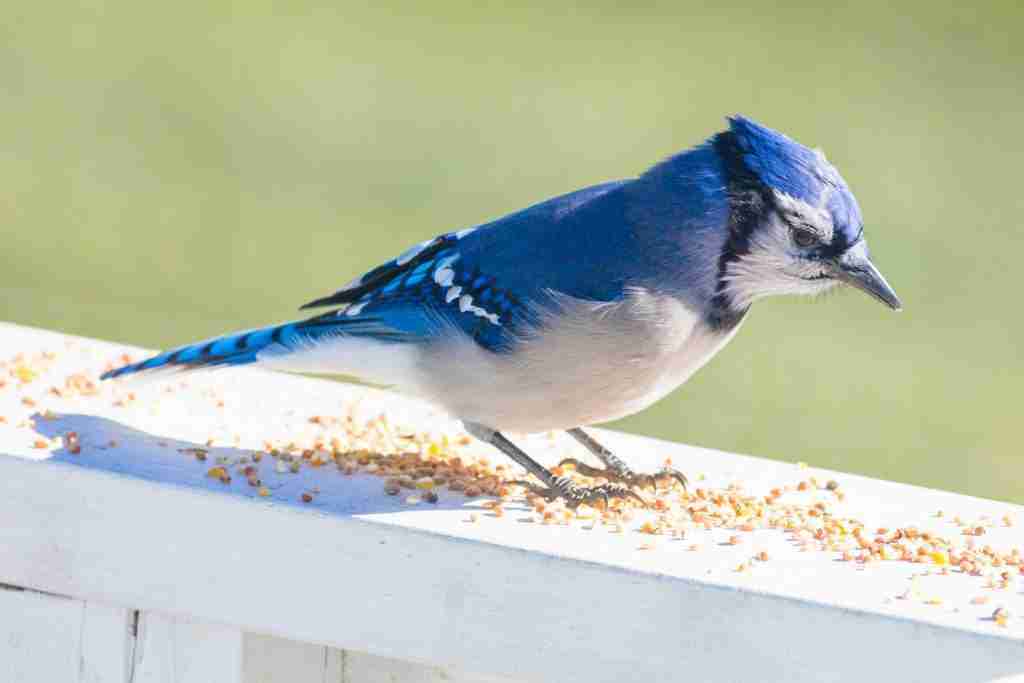
Blue Jays are one of the most easily recognizable birds in North America. They are medium-sized birds with blue feathers and a white chest. Blue Jays are found in wooded areas across the United States and Canada. These birds eat mostly insects and nuts. Blue Jays are known for their loud calls, which can be heard from far away.
Blue Jays are a common sight in Arkansas. These birds can be found in wooded areas throughout the state. Blue Jays typically eat insects and nuts, but they will also eat fruits and berries. These birds are known for their loud calls, which can be heard from far away.
If you see a blue jay in Arkansas, you can be sure that you are in the presence of a true Arkansas native. These birds are an important part of the state’s ecosystem and play a vital role in the state’s economy.

Northern mockingbirds
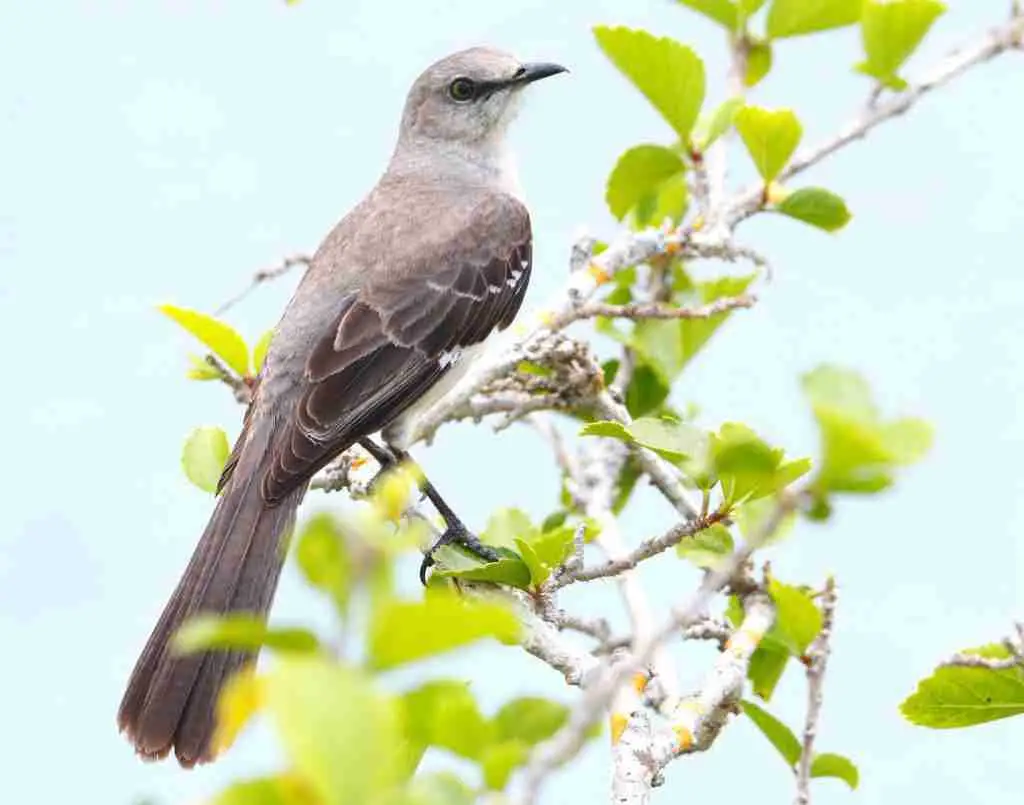
Mockingbirds are about nine to eleven inches in length. They have a wingspan of fourteen to sixteen inches. The adult mockingbird has gray upperparts and white underparts. The tail is long and black with white bars. There are two white wingbars on the gray wings.
The bill is black and the legs are pinkish-gray. Northern mockingbirds have a gray head with a black cap and white eyebrows. They have yellow eyes. Male and female mockingbirds look alike.
Juvenile mockingbirds are similar to adults, but they have brown upperparts and their underparts are streaked with brown.
Mockingbirds are found in the southern United States, Mexico, and Central America. They prefer open areas such as fields, pastures, and roadsides. Mockingbirds are also found in urban areas such as parks and gardens.
Mockingbirds eat insects, berries, and fruits. They forage on the ground for food.
Mockingbirds are active during the day. They sing at dawn and dusk.

Tufted Titmouse
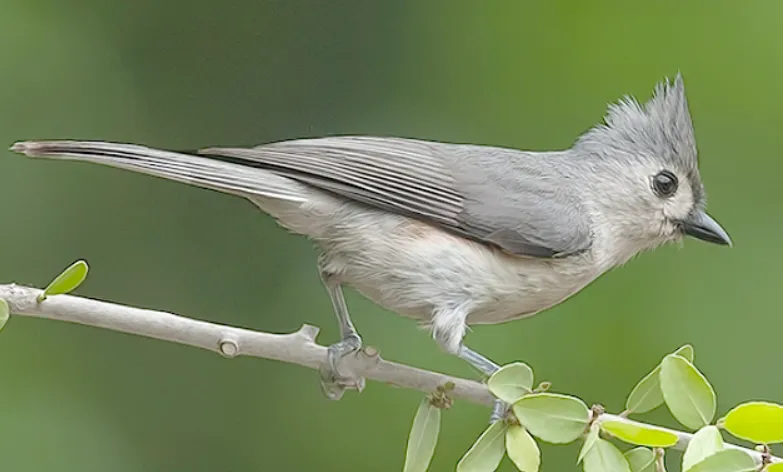
Tufted Titmouse is a small bird with gray upperparts and white underparts. The head has a black cap and crest, white eyebrows, and black eyes. It is similar in appearance to the closely related Black-capped Chickadee.
The Tufted Titmouse is found in woodlands throughout much of eastern North America. It is a year-round resident in the southern parts of its range, but northern birds may migrate south for the winter.
The Tufted Titmouse is a small bird, measuring about five to six inches in length. It has a stout body and a relatively long tail. The wings are short and rounded. The legs and feet are black.

Eastern Bluebird
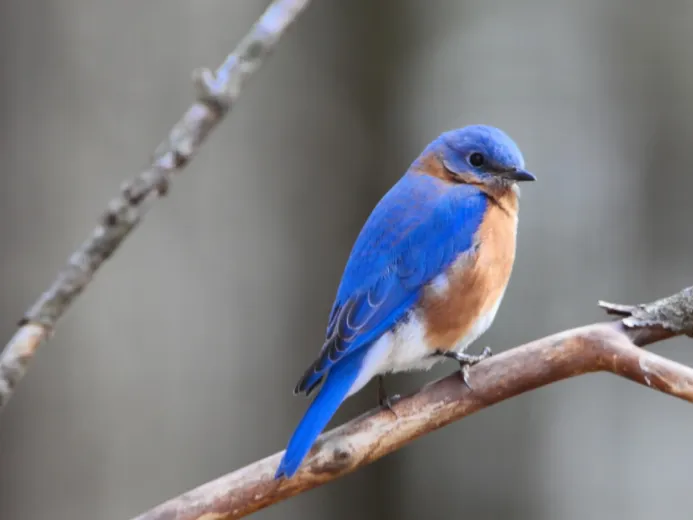
The Eastern Bluebird is a small thrush with blue upperparts and rusty-red breast. The adult male has a blue head and back with a red throat and breast. The adult female has a grayish-blue head and back with a red throat and breast.
Juveniles have brown upperparts with rusty-red throats and breasts. These birds are found in open woodlands, farmlands, and parks. Their diet consists of insects and berries. They are about six to seven inches in length with a wingspan of ten inches.
These birds mate for life and build their nests in trees or shrubs. The female lays three to seven eggs which hatch in about two weeks.The young fledge in about three weeks. These birds are non-migratory and can be found in Arkansas year-round.

Dark-eyed Junco
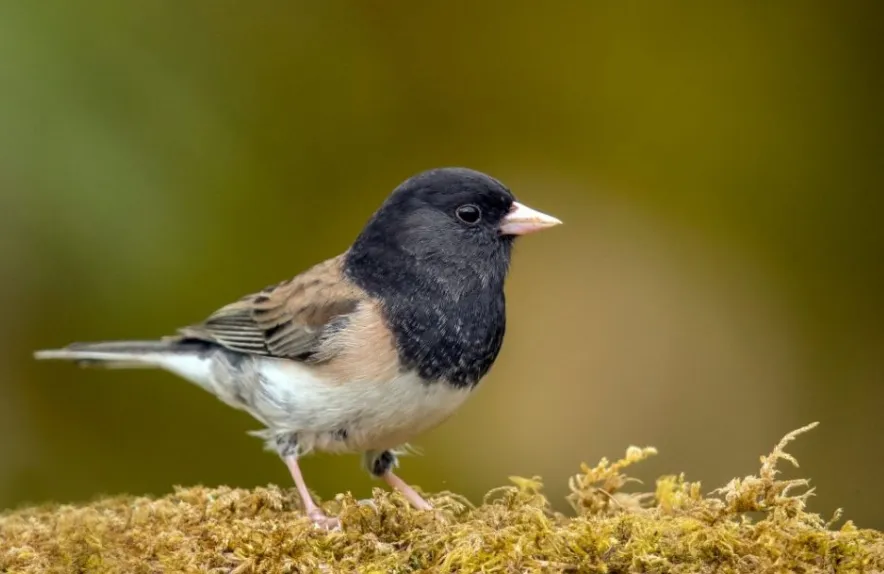
The Dark-eyed Junco is a small sparrow with a gray body and white belly. It has a dark hood and tail, and pinkish legs. The female is similar to the male, but browner overall.
This bird can be found in woodlands, brushy areas, and mountain meadows across North America. In Arkansas, it is a common winter bird.
The Dark-eyed Junco forages on the ground, eating mostly seeds and insects. In winter, it often feeds in flocks with other juncos and sparrows.
This bird nests in trees or shrubs, usually close to the ground. The female builds the nest out of twigs, grass, and other plant material. She lays three to seven eggs, which are white with brown spots.
The Dark eyed Juncos are songbirds, and their call sounds like a metallic click. Its song is a series of trills and warbles.

Carolina Wren
(Thryothorus ludovicianus)

The Carolina wren is a small songbird with a body length of about five to six inches. Its upperparts are reddish brown, while its underparts are pale gray.
The Carolina wren has a white stripe above its eye and a long curved bill. This bird is found in woods and gardens across the eastern United States. The Carolina wren is a non-migratory bird.
The Carolina wren is a insectivore, meaning that its diet consists mostly of insects. This bird also eats spiders, snails, and other small invertebrates. The Carolina wren forages on the ground or in low vegetation.
This bird nests in cavities, such as holes in trees or nest boxes. The Carolina wren is a non-migratory bird. It is a permanent resident of its range, which includes the eastern United States.

Carolina Chickadee
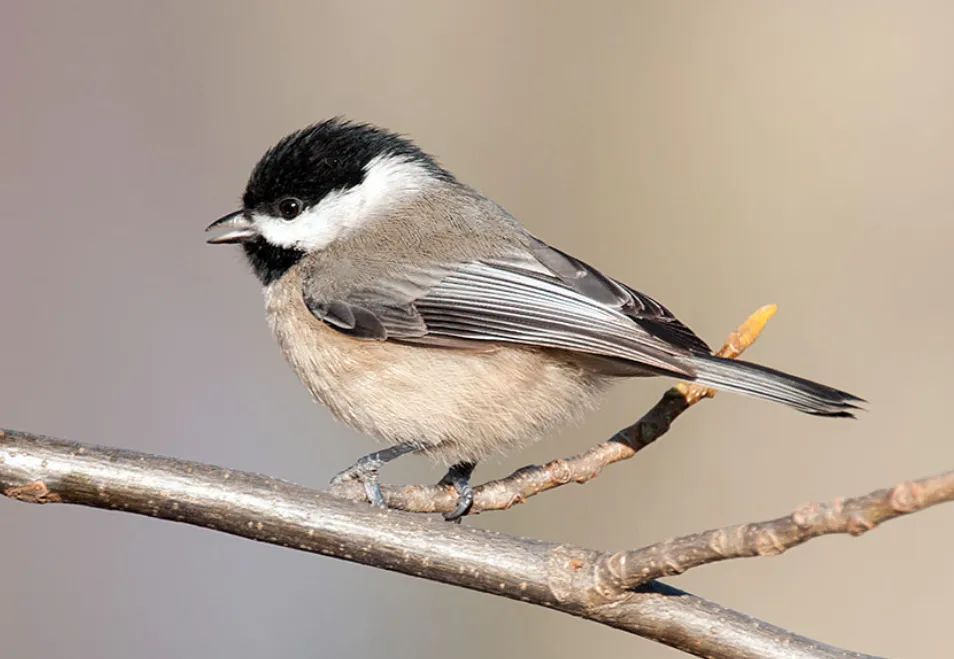
The Carolina Chickadee is a small, black and white bird with a gray cap. They are found in woodlands and forests throughout the southeastern United States. Carolina Chickadees eat insects, spiders, and black oil sunflower seeds.
They nest in tree cavities and will often use man-made nesting boxes. Carolina Chickadees are active birds that are constantly searching for food. They are also known to be very curious and will often approach humans.
Carolina Chickadees are a common backyard bird in Arkansas. If you see one, be sure to watch it for awhile as they are sure to entertain you!

American Crow

American Crows are the largest member of the crow family. They can be found in woodlands, marshes, and swamps throughout Arkansas. These birds are black with a glossy sheen and have a wingspan of up to four feet. Their diet consists mostly of insects, small mammals, and reptiles.
American Crows are known to be aggressive and will often chase away smaller birds from their territory. These birds are also known to be excellent mimics and can imitate the calls of other birds and animals.
American Crows are most active during the day and can often be seen perching in trees or flying in large flocks.
American Crows are one of the most common bird species in Arkansas. American Crows are known to be aggressive and will often chase away smaller birds from their territory.
These birds are also known to be excellent mimics and can imitate the calls of other birds and animals. American Crows are most active during the day and can often be seen perching in trees or flying in large flocks.
These birds are found in woodlands, marshes, and swamps throughout Arkansas and typically eat insects, small mammals, and reptiles.

Mourning Doves
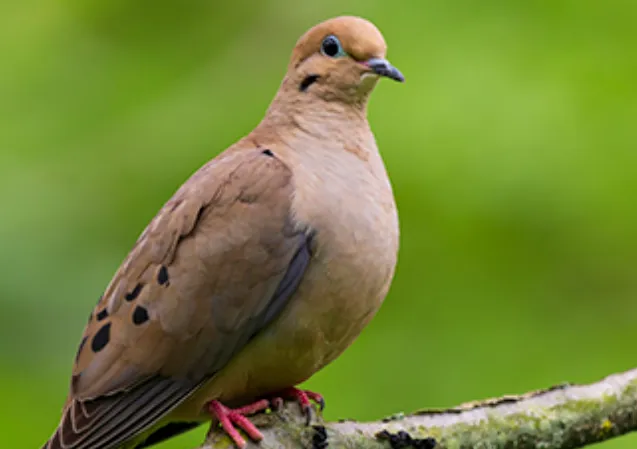
Mourning Doves are one of the most common birds in North America. They are medium-sized birds with long tails. The adult has grey-brown upperparts, pale underparts, and a black bill. Juveniles have browner plumage.
Mourning Doves are found in open habitats such as fields, parks, and gardens. They eat seeds and fruits. Mourning Doves are monogamous and mate for life. Both parents build the nest and care for the young. The female usually lays two eggs.
When threatened, Mourning Doves will dive away from the predator while calling loudly. If this does not work, they will feign death by lying on the ground with their heads pulled back.
Mourning Doves are one of the few birds that can drink by sucking up water into their bill and letting it run down their throat into their body.
Mourning Doves are gentle creatures and are considered a symbol of peace. In Native American culture, they are seen as a sign of hope. The Mourning Dove is the state bird of Arkansas.

Red-bellied Woodpecker
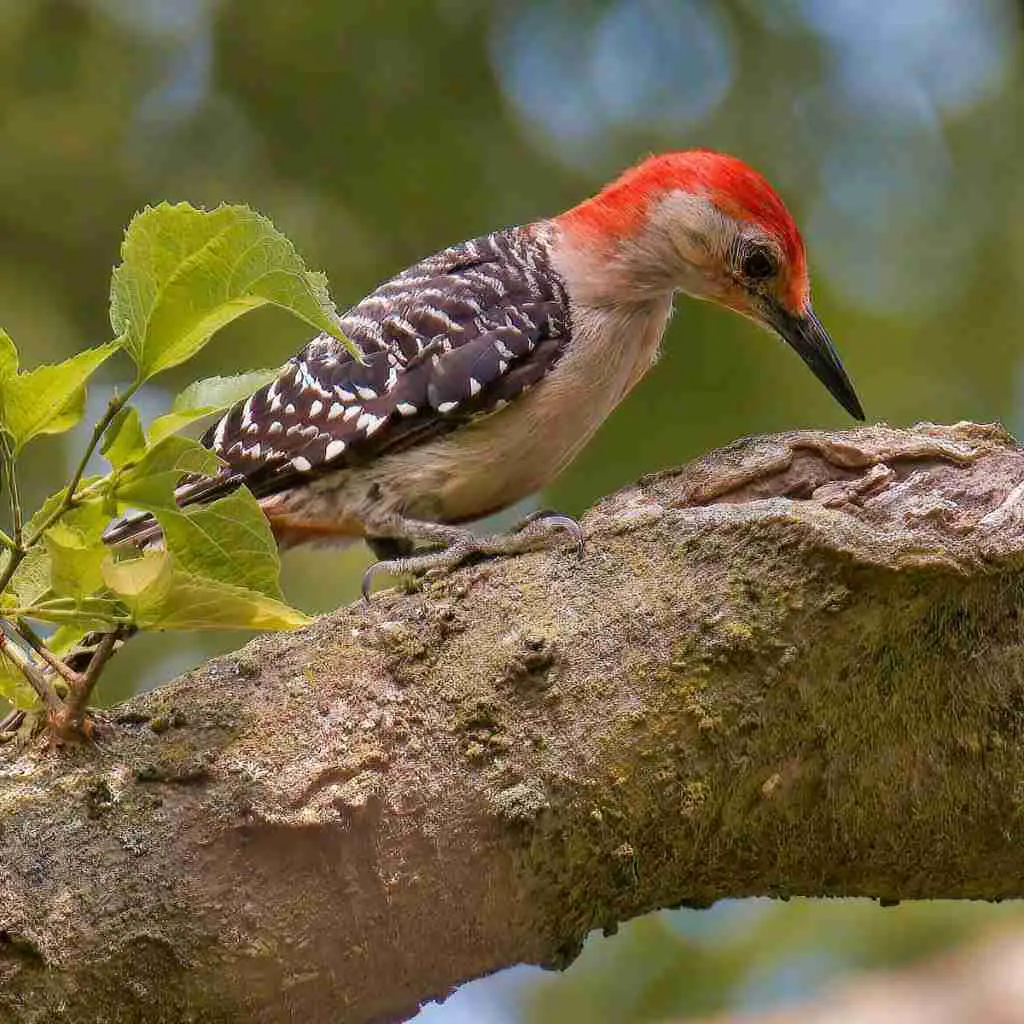
The Red-bellied Woodpecker is a small to medium sized woodpecker with black and white plumage. The back is mostly black, while the underparts are white with some black barring.
The head has a red cap that extends down the nape, and there is a small patch of red feathers on the belly. Both sexes are similar in appearance, but juveniles have a duller cap and no red on the belly. This woodpecker can be found in woodlands and forests throughout the eastern United States.
It is a common bird that is often seen at backyard bird feeders. The diet of the Red-bellied Woodpecker consists of insects, fruits, and nuts. It will also occasionally eat small reptiles and birds.
This woodpecker excavates nesting cavities in trees, and will often use man-made structures such as houses and utility poles. The Red-bellied Woodpecker is a fairly active bird, and can often be seen climbing tree trunks in search of food. It has a loud, resonant call that sounds like “kleek-kleek-kleek”. The Red-bellied Woodpecker is a common and widespread bird that is not considered to be at risk of extinction.

Red-winged Blackbird
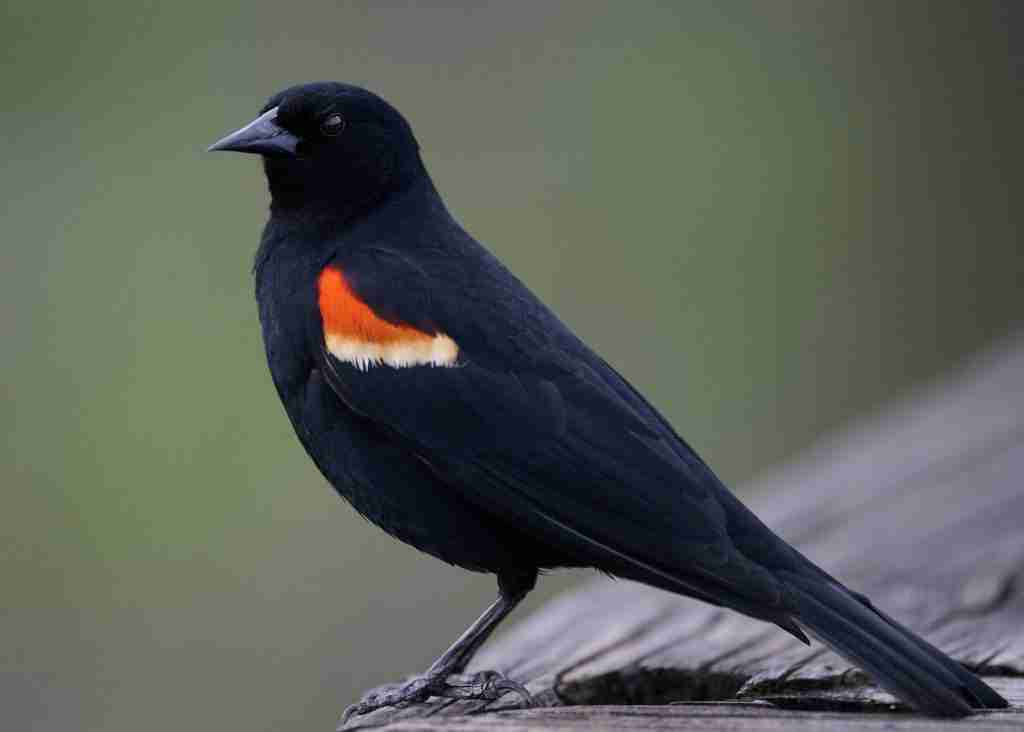
(Agelaius phoeniceus) is a species of a true blackbird in the family Icteridae. They are about 16.75 cm (66 in) long with a wingspan of 38 cm (15 in). Males have black feathers with red wing bars and yellow eyes. Females look similar but have brownish-black feathers. The Red-winged Blackbird is sexually dimorphic.
The diet of the red-winged blackbird consists mainly of insects, especially in the breeding season. They will also eat rice, waste grain, and sunflower seeds. In winter, their diet switches to include more fruits and berries.
The red-winged blackbird is a native species to North America. Their breeding habitat is marshes and wetlands across Canada, the United States, and northern Mexico.
They make small nests out of grasses and weeds near the ground in these areas. In winter, they will migrate to southern parts of the US as well as Central America.

White-throated Sparrow
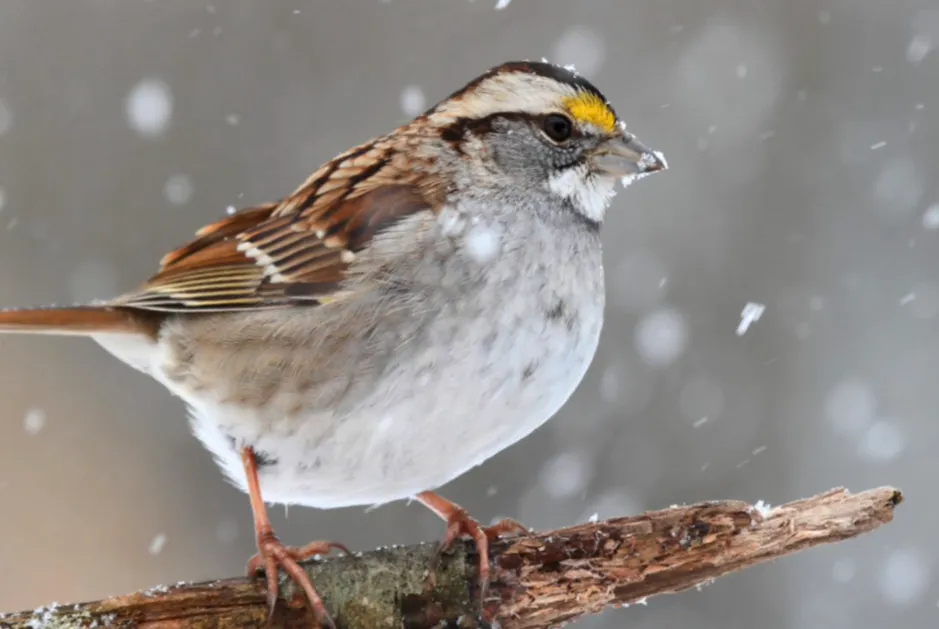
White-throated Sparrows are small birds with a white throat and breast with brown streaks on their back. The wings are brown with white bars. The bill is pinkish-brown and the legs and feet are grey. White-throated Sparrows are about five to six inches long.
White-throated Sparrows eat mostly insects but will also eat seeds. They forage on the ground in leaf litter or in low vegetation.
White-throated Sparrows breed in coniferous and mixed forests in Canada and the northern United States. In winter, they move south to the southern United States, Mexico, and Central America.
White-throated Sparrows are shy birds that are usually found in pairs or small groups. They are more likely to be heard than seen as they sing a repetitive song that sounds like “old-sam-peabody-peabody-peabody” with the last note being higher than the others.

Northern Cardinals
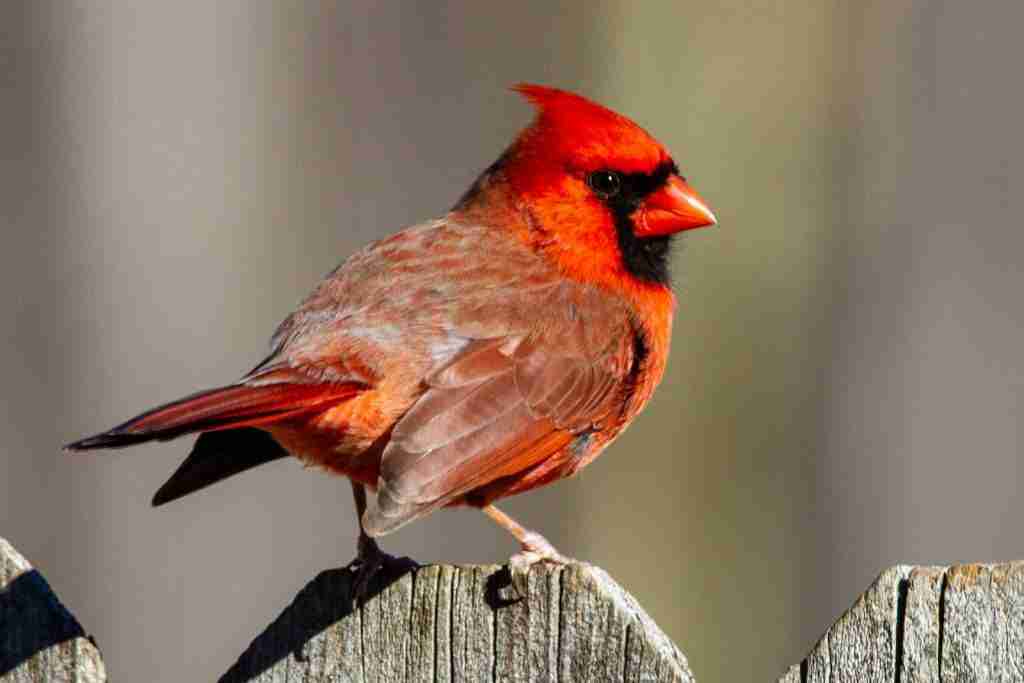
Northern Cardinals are one of the most recognizable birds in North America. They are easily identified by their bright red plumage. Cardinals are also relatively large songbirds, measuring approximately nine inches in length.
The diet of Northern Cardinals consists primarily of seeds and fruits. However, they will also eat insects on occasion. In terms of habitat, Cardinals are found in a variety of different environments including forests, woodlands, and even urban areas.
When it comes to behavior, Cardinals are generally quite social birds. They often form pairs or small groups and can be seen perching in trees or on power lines. Cardinals are also known for their beautiful songs which they typically sing during the early morning hours.

Brown-headed Cowbird
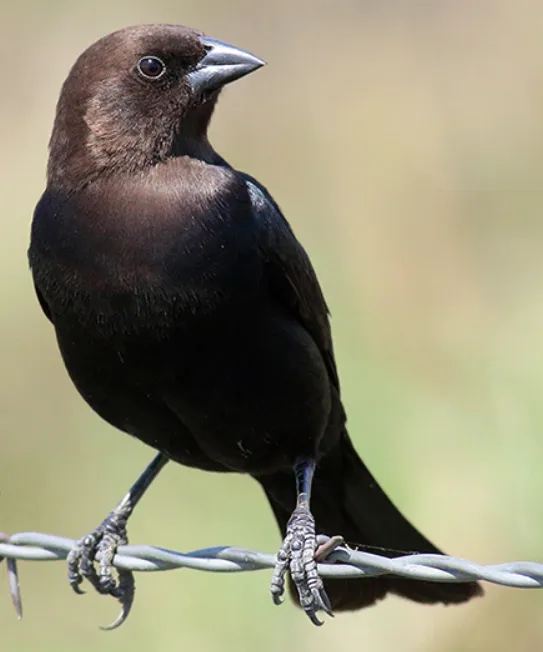
Brown-headed Cowbird females are small birds, measuring only about six inches in length. They have brown heads and necks, with the rest of their body being a dull gray color.
Their diet consists mainly of insects, which they catch on their wing. Brown-headed Cowbirds typically live in wooded areas near fields or pastures, where there is an abundance of insect prey. These birds are known for their parasitic behavior, which involves laying their eggs in the nests of other bird species.
The host birds then raise the cowbird chicks as their own, to the detriment of their own offspring. Brown-headed Cowbirds are relatively sedentary, meaning they do not migrate long distances. However, they will move short distances to find suitable habitats.

House Sparrow
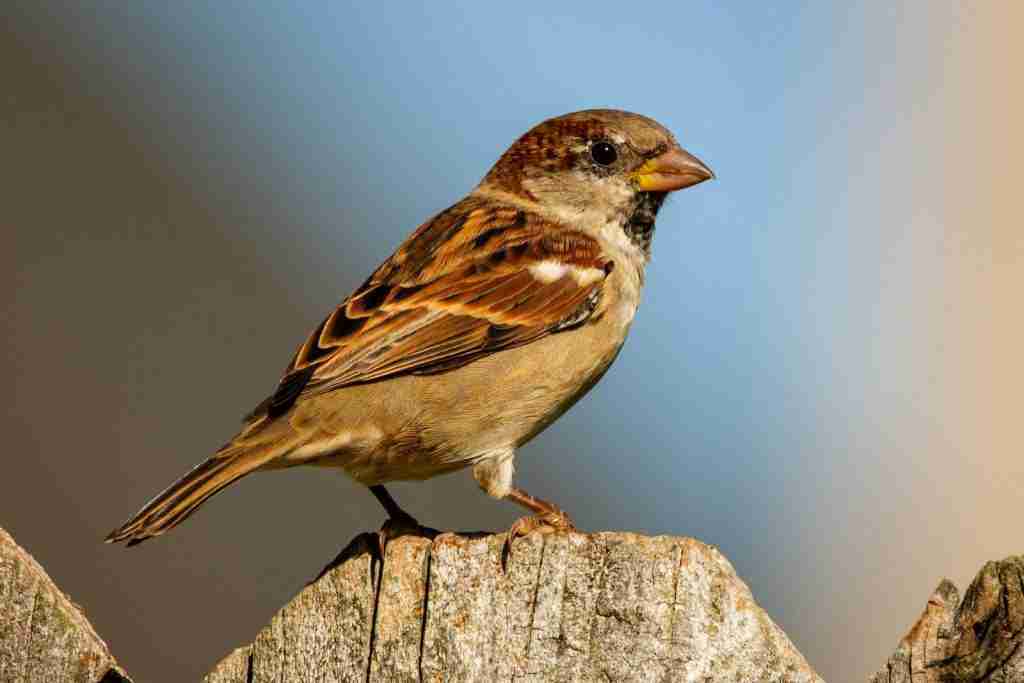
House Sparrows are one of the most common birds in North America. They can be found in nearly every state, including Arkansas. House Sparrows are small birds with brown and gray feathers. They have a white belly and a black stripe down their throat. Male House Sparrows also have a black patch on their chest. These birds are about six inches long and weigh about one ounce.
House Sparrows eat mostly seeds and insects. They will also eat berries and other fruits. House Sparrows live in a variety of habitats, including forests, fields, and urban areas. These birds are often seen near houses and buildings. House Sparrows are social birds that live in flocks. They can be aggressive towards other birds, especially during the breeding season.
House Sparrows are not endangered, but their numbers have been declining in recent years. This is likely due to a loss of habitat and changes in the way we use land. You can help these birds by providing nesting boxes and food sources in your yard or community.

American Robin
(Turdus migratorius)
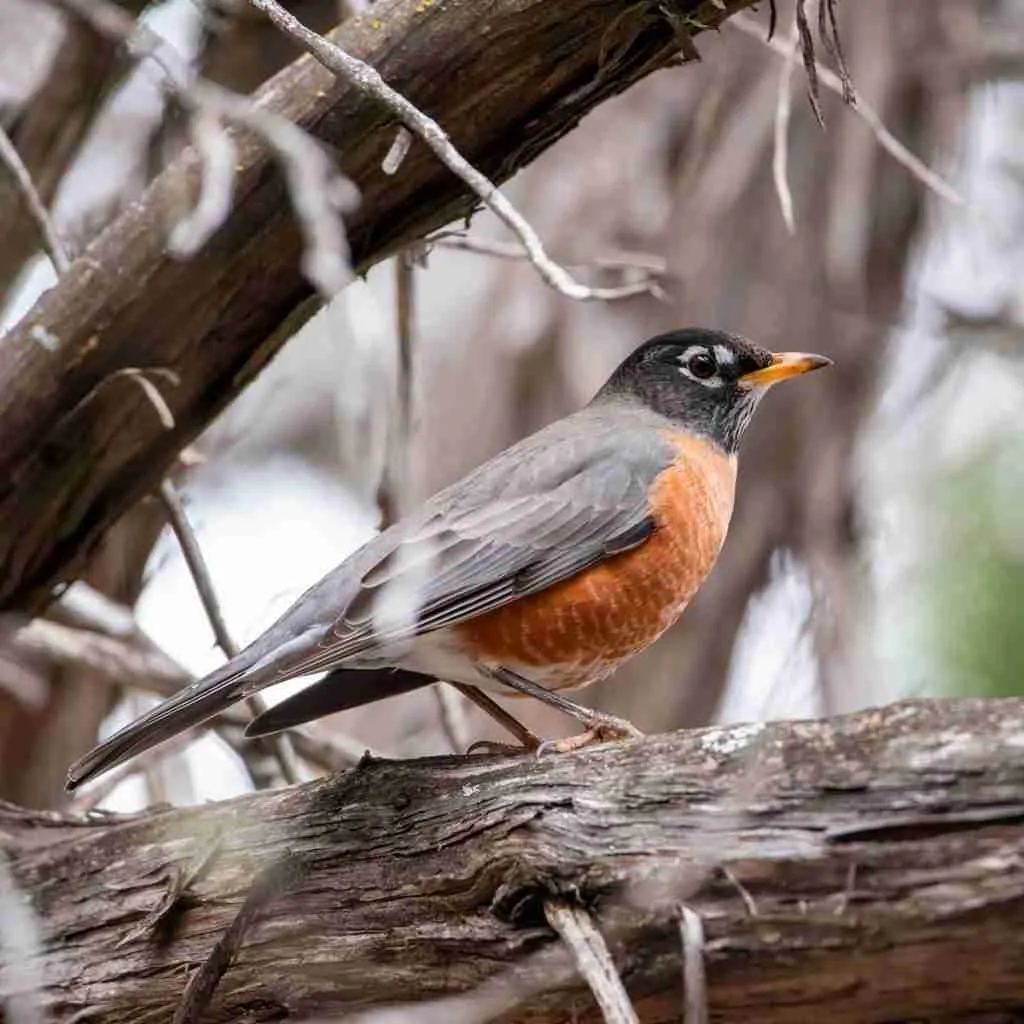
The American Robin is a plump bird with a round body and long legs. Its back is dark brown, its breast is orange-red, and its belly is white. It has a black head with a white throat and eyes surrounded by blue-gray feathers. The robin’s bill is black, and its legs and feet are dark brown. It is about the size of a human fist.
The American Robin is found in woods, gardens, parks, and open fields across North America. It eats insects, earthworms, berries, and fruits. The robin builds its nest in trees or on buildings. It lays three to five eggs that are blue-green with brown spots.
The American Robin is a songbird that is known for its melodious voice. It sings a variety of songs, including a loud, clear whistle and a soft warble. The robin is also known for its ability to imitate the sounds of other birds. The American Robin is active during the day and roosts at night. It is a social bird that forms flocks of up to 100 birds.
The American Robin is the state bird of Connecticut, Michigan, and Wisconsin.

Indigo Bunting
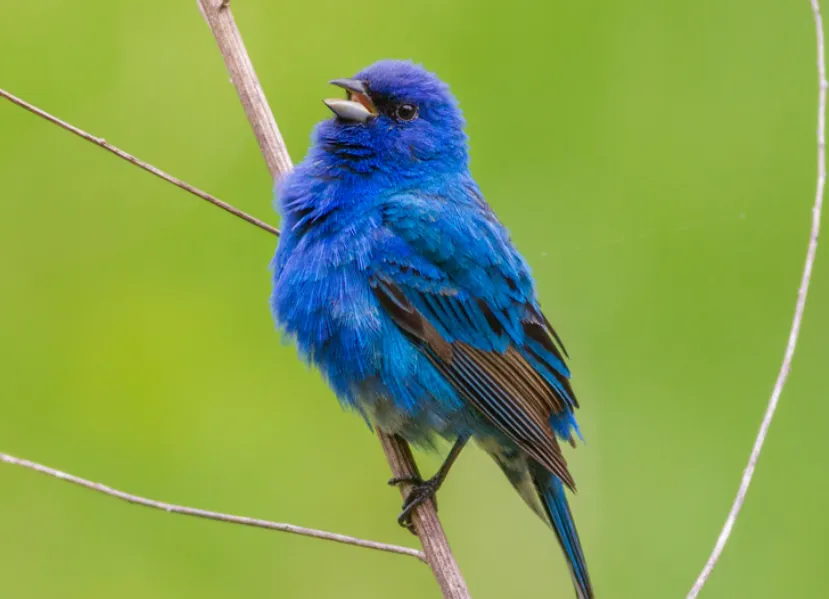
The male Indigo Bunting is a small songbird with vibrant blue plumage. They are found in open woodlands and brushy areas across the eastern United States. Their diet consists mainly of insects, but they will also eat berries and other fruits.
Male buntings are polygamous and will mate with multiple females. The female builds the nest and incubates the eggs. Both parents help to raise the young. Indigo Buntings are not considered to be threatened or endangered. They have a fairly large range and their population is stable.
However, like many other songbirds, they are declining in some areas due to habitat loss.

Downy Woodpecker
(Picoides pubescens)
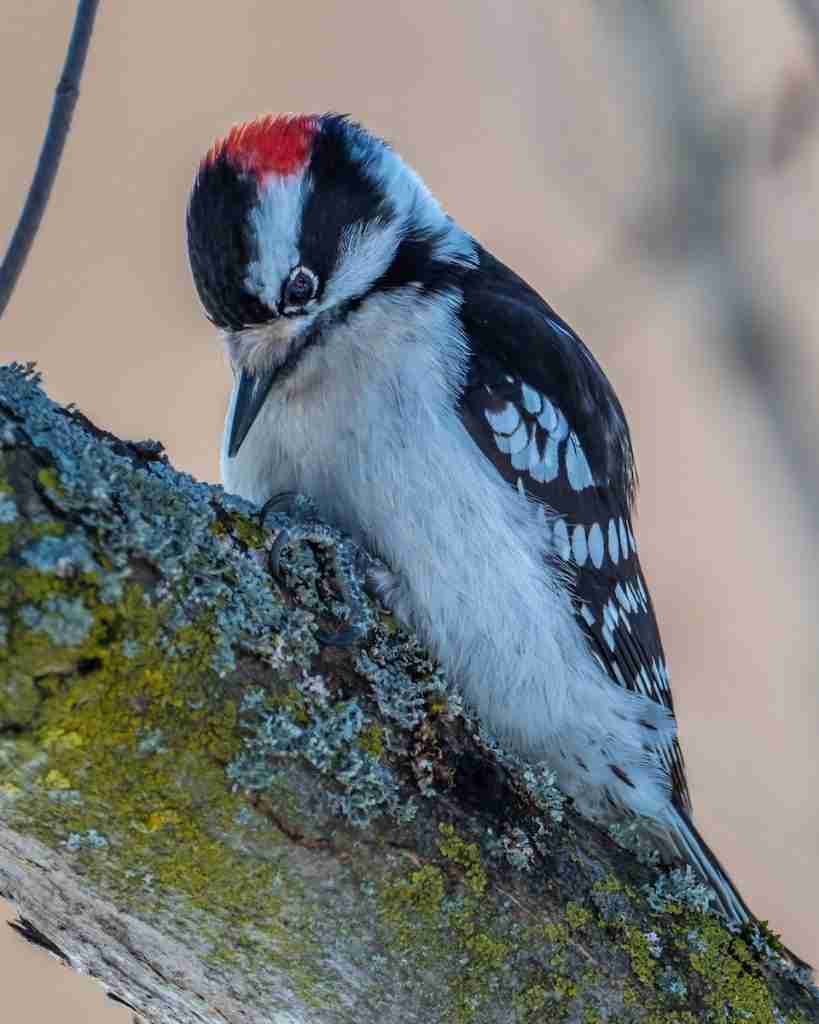
The Downy Woodpecker is the smallest woodpecker in North America, measuring just six to seven inches in length. The adult male has a black back and white belly, with a small red patch on the back of his head.
The female looks similar but has a gray back. Both sexes have white spots on their wings, whitetails with black bars, and black-and-white striped faces. Juveniles look like adults but with duller plumage.
These woodpeckers are found in forests throughout North America east of the Rocky Mountains. They prefer deciduous woods but can also be found in mixed forests and coniferous forests. They are year-round residents in most of their range, but some northern birds do migrate south for the winter.
Downy Woodpeckers eat insects, spiders, and other small invertebrates that they find by pecking at tree bark. They also eat fruits and berries. These birds nest in holes they excavate in trees. Both sexes help to excavate the nest and care for the young.
Downy Woodpeckers are active during the day, and they are often seen climbing tree trunks in search of food. They will also come to backyard bird feeders to eat suet, seeds, and nuts. These birds are interesting to watch as they hop their way up and down tree trunks, hang upside down from branches, and fly from place to place in a zigzag pattern.

Song Sparrow
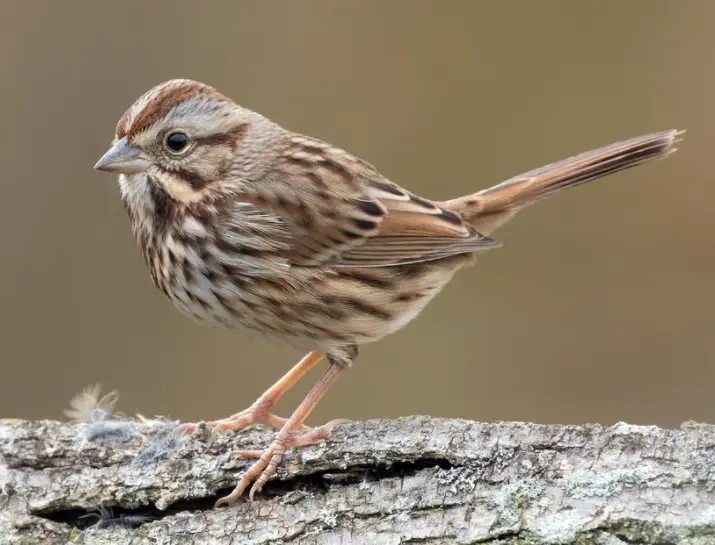
Song Sparrows are one of the most widespread and easily recognized birds in North America. They can be found in nearly every habitat, from forests to deserts, and are a common sight in many backyard bird feeders. Here are some things you may not know about these little brown birds.
Song Sparrows get their name from their beautiful singing voices. Male Song Sparrows will sing a complex series of notes to attract mates and warn other males away from their territory.
Despite their small size, Song Sparrows are fierce defenders of their nests. They will often attack much larger birds, such as crows and jays, that come too close.
Song Sparrows are highly adaptable birds, and their diet reflects this. In addition to seeds and insects, they will also eat fruits, berries, and even small amphibians.
While most Song Sparrows stay within North America, some birds do migrate south for the winter months. These migrants can be found as far away as Central America and the Caribbean islands.

House Finch
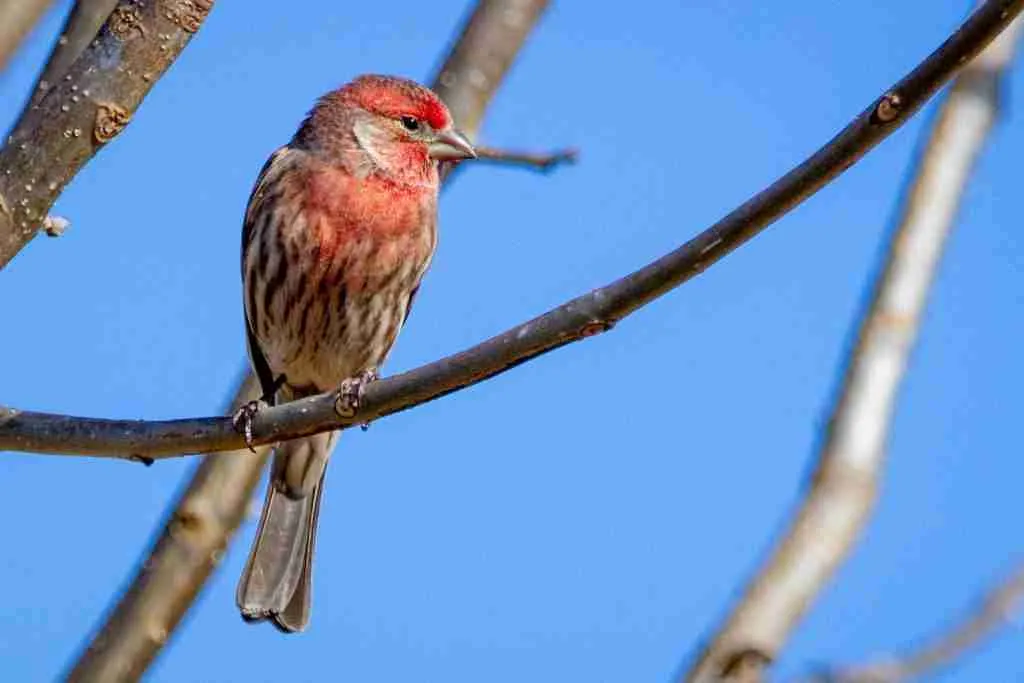
The house finch is a small bird with a reddish brown back and a gray belly. They have a white stripe above their eyes and black stripes on their wings. Male house finches have red heads, while females have brown heads. These birds are about the same size as a sparrow.
House finches eat mainly seeds, but they will also eat insects. They build their nests out of twigs and grass in trees or on buildings. House finches are found in open areas such as fields, parks, and gardens.
These birds are not afraid of humans and will often build their nests close to homes. House finches are active during the day and are usually seen in pairs or small groups.

What are the most common birds in Arkansas?
There are many common birds in Arkansas, but some of the most common include the American Crow, Northern Mockingbird, and European Starling. These birds can be found in many different habitats throughout the state. However, they are most commonly seen in urban areas.
What is Arkansas’s state bird?
The Arkansas state bird is the mockingbird. The mockingbird is a small songbird that is gray and white in color. The mockingbird is known for its ability to mimic the sounds of other birds and animals. The mockingbird can also be found in other states, such as Texas, Louisiana, and Mississippi.
Are Ravens in Arkansas?
The answer to this question is a little complicated. Ravens are not native to Arkansas, but they have been seen in the state. It is believed that these birds were brought to Arkansas by people who owned them as pets. Ravens are not considered to be a threat to the state’s ecosystem, but they are still monitored by the Arkansas Game and Fish Commission. If you see a raven in Arkansas, it is likely that it was brought there by a human.
Are Cardinals common in Arkansas?
The answer is yes, Cardinals are quite common in Arkansas. In fact, they are the state bird! Cardinals are easily recognizable with their bright red plumage and black mask. They are relatively large birds, measuring about nine inches from beak to tail.
How do I identify a bird in my backyard?
The best way to identify a bird in your backyard is by its appearance. Look for the following:
-Size
-Shape
-Color
-Behavior
If you can, use binoculars or a spotting scope to get a better look. You can also take pictures or videos of the bird to help with identification. Once you have an idea of what the bird looks like, consult a field guide or use an online identification tool to help narrow down your options. Don’t forget to pay attention to the time of year and where you are located, as this can also help with identification. With a little patience and some careful observation, you should be able to identify the bird in your backyard.
What big birds live in Arkansas?
According to the Arkansas Audubon Society, there are twelve species of big birds that live in Arkansas. They are the American white pelican, brown pelican, double-crested cormorant, turkey vulture, osprey, bald eagle, golden eagle, Cooper’s hawk, northern goshawk, red-tailed hawk, ferruginous hawk, and swallow-tailed kite.
These big birds can be found in different parts of the state, depending on the time of year. Some, like the American white pelican, are only here during the summer months. Others, like the bald eagle, can be found throughout the year.
How many species of birds are in Arkansas?
There are 314 species of birds that have been documented in Arkansas. This number is constantly changing as new bird species are discovered and added to the list.
The Arkansas Audubon Society is a great resource for birders in the state. They offer many programs and events that help people learn about and enjoy watching Arkansas birds.
What are winter birds in Arkansas?
There are a variety of winter birds that can be found in Arkansas. Some of the more common ones include: American goldfinches, black-capped chickadees, downy woodpeckers, northern cardinal, and red-bellied woodpeckers.
While you’re out birdwatching this winter, see if you can spot any of these feathered friends! Arkansas is a great place for birdwatching all year round.
Bird feeders
Bird feeders are a great way to attract birds to your yard or garden, and they can be fun and easy to make! Here are a few simple tips for making your own bird feeder:
-Start with a clean, dry container. Glass jars or plastic containers work well.
-Poke holes in the bottom of the container for drainage.
-Fill the container with birdseed, and be sure to include a mix of seeds that birds will find appealing.
– Hang the feeder in a place where birds can easily find it, and enjoy watching them eat!
If you’re looking for a creative way to add some beauty to your yard or garden, consider making your own bird feeder! It’s a fun project that everyone can enjoy, and it’s a great way to attract birds to your property.

An avid ornithologist, zoologist and biologist with an unwavering passion for birds and wild animals.
Dr. Wilson’s journey in ornithology began in childhood and led him to obtain a Ph.D. in Ornithology from the prestigious Avian Research Institute. He has worked closely with renowned experts in the field and conducted extensive research and field studies globally.

